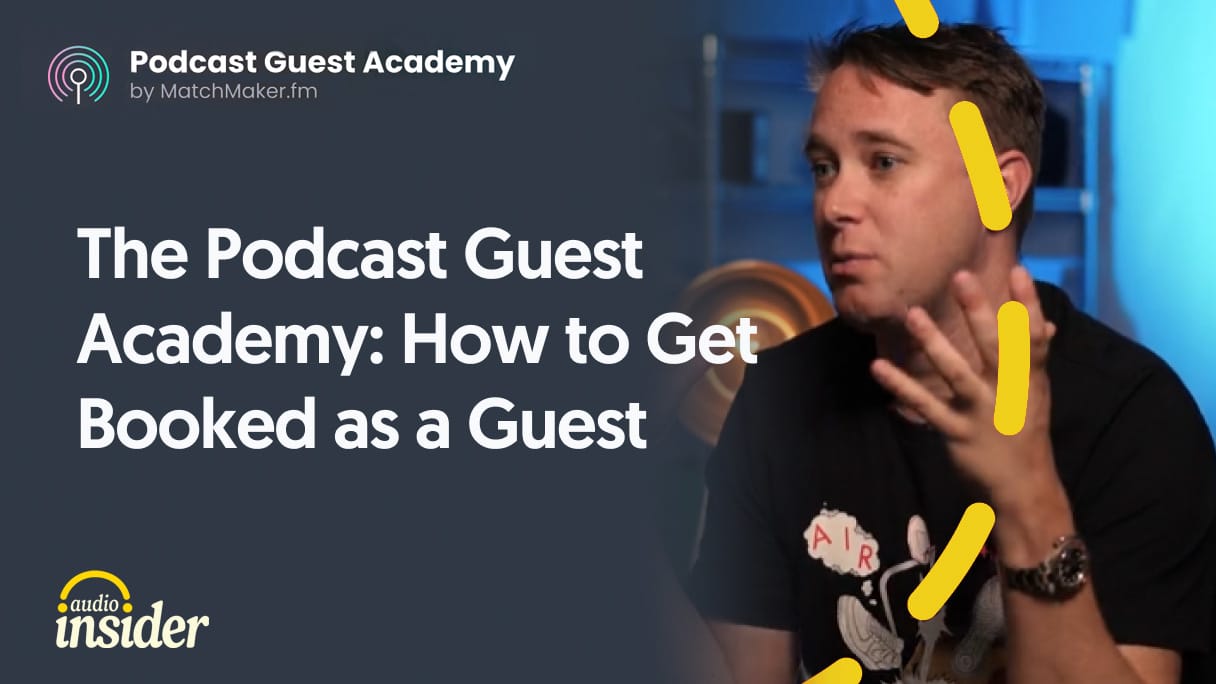You’ve nailed the interview. The host laughed at your jokes, you dropped some mic-worthy insights, and you’re feeling like a rockstar. But here’s the question — did that podcast appearance do anything for you?
Beyond the warm fuzzies and the thrill of seeing your name in the episode title, was it worth the time and effort? Measuring your results is how you find out.
In this article, we’ll walk through the key metrics to track, the tools to measure them, and how to spot those intangible wins that can pay off long after the episode airs.

Why measuring podcast guesting success matters
Getting booked on a podcast might feel like a big win, but it’s only the starting line. The true measure of success is whether your appearance achieved what you set out to do. Maybe your goal was to grow your email list, sell more books, build credibility in your niche, or connect with potential collaborators. If you don’t measure the outcome, you’ll never know if the effort paid off.
Without precise tracking, podcast guesting can easily turn into a scattershot PR effort — lots of activity with no real direction. By defining your goals up front and measuring against them afterward, you turn each interview into a strategic opportunity rather than a one-off moment. You can see what works, what doesn’t, and where to adjust, making every future pitch and appearance more effective.
Key metrics to track
So what should you be tracking? There’s no one-size-fits-all answer, but there are a handful of metrics that almost every guest can benefit from watching.
Audience growth
This is about reach — how many new people discovered you because of the interview. This could be new social media followers, new podcast subscribers, or a bump in your newsletter sign-ups.
The key question here is: Did more people start paying attention to you because of that interview? Track your numbers before and after the appearance to see the change. You can use tools like Google Analytics to monitor traffic to your website or built-in analytics on social platforms to spot patterns.
Engagement and conversions
This measures action — what those listeners did next. Did they click your links, download your freebie, book a call, or buy your product? Here, you’re not measuring how many found you, but how many took a step closer to becoming a client, customer, or community member. This shows if your message resonated enough for them to act.
Brand mentions and backlinks
This is the ripple effect — these capture the indirect benefits of your podcast appearances. A mention is when your name, business, or work is referenced online, from the show’s episode description to social media shoutouts. Backlinks are links to your website from those mentions, which can improve search rankings and bring in new visitors.
Tracking these shows you how far your message travels beyond the episode itself, and whether your guest spots are boosting your discoverability in the long run.

Tools and methods for measuring results
Tracking your success as a podcast guest doesn’t need to be complicated, but you do need the right tools for the job. The tools you choose will depend on the metrics you’re tracking.
Analytics platforms
These platforms take the guesswork out of tracking results by showing exactly where your growth, engagement, and visibility are coming from.
- For audience growth: Use podcast analytics from your hosting platform, along with tools like Apple Podcasts Connect, Spotify for Podcasters, or Chartable to monitor download spikes after an appearance. Social media analytics (Instagram Insights, X/Twitter Analytics, LinkedIn analytics) can also reveal if you’ve gained followers during that period.
- For engagement and conversions: Google Analytics can show referral traffic from the podcast’s website, and email marketing platforms like Mailchimp or Kit will track new signups. If you shared a unique landing page or discount code during the interview, check its traffic or redemption rate to measure direct conversions.
- For brand mentions and backlinks: Use tools like Google Alerts, Ahrefs, or SEMrush to track when your name or website is mentioned online. These will also show any backlinks added from podcast episode pages, which can improve SEO over time.
Tracking links and codes
If you want to know exactly where your traffic, sign-ups, or sales are coming from, tracking links and codes are essential. The most reliable way is to use UTM links, which are URLs with short tracking tags that tell your analytics tools exactly which campaign or appearance brought someone to your site. You can build them easily using Google’s Campaign URL Builder or any UTM generator.
For example, you could create a link with tags for the source (e.g., “JanePodcast”), medium (“podcast”), and campaign (“fitness_launch”). Share this exact link only during your guest spot. When someone clicks, the data in Google Analytics will clearly show that the visitor came from that interview.
For product sales or special offers, consider creating podcast-specific discount codes. Most e-commerce or booking platforms make this easy. For example, on Shopify, Gumroad, or WooCommerce, you can create a promo code right in your dashboard. Make sure that the code is memorable, set the rules (remember scarcity drives action) and then track the number of times the code was used and the revenue it generated. That’s your direct measurement of conversions from that podcast appearance.
If you are on The Jane Podcast to talk about your new fitness program, you can create a 20% off code in Shopify called JANE20, valid for two weeks after the release date. During the interview, you say: "If you’d like to try my program, you can get 20% off at mysite.com with the code JANE20. Valid until April 15th, 2025." Now you know exactly how much revenue that single podcast appearance generated.

How to assess qualitative benefits
Qualitative benefits are the intangible results you get from podcast guesting — the ones you can’t measure in clicks, sales, or follower counts. They include things like your reputation, authority, and relationships in your industry.
They matter because these benefits often have a longer shelf life than immediate metrics. Building credibility, earning trust, and forming valuable connections can lead to opportunities that bring growth over months or years, even if they don’t produce instant, trackable results. By paying attention to these less tangible wins, you get a fuller picture of the real impact your guest appearances are having.
Media coverage and invitations
Journalists, event organizers, and other podcasters listen to podcast shows for inspiration and expert sources. If your interview is relevant, insightful, or sparks conversation, it can naturally position you as someone worth featuring elsewhere.
Podcasts also have a unique advantage in that episodes are evergreen and searchable. Months after release, your interview can still surface in searches or be recommended, giving you ongoing visibility that might lead to an email from a conference organizer or a DM from a media outlet. In other words, one strong guest spot can keep opening doors long after the recording ends. But only if you’ve delivered value, made your expertise clear, and left listeners (and potential collaborators) wanting more.
Partnership opportunities and collaborations
Speaking of collaborations, podcast appearances can open doors to partnerships you might never have found otherwise. When you share your story with an audience that already cares about your topic, you are also speaking directly to business owners, creators, and brands who share your values and goals. They can instantly see the fit for teaming up, whether that is a joint marketing campaign, a co-branded product, or a special event.
Podcasts give you the space to go beyond a surface-level pitch. You can explain your process, share wins, and show your personality — all of which help potential partners picture what working together would look like. Because episodes live online indefinitely, these opportunities aren’t limited to the week your interview drops. Someone could hear your episode months later and still reach out with a collaboration idea.
Audience feedback and testimonials
And last but not least, podcast guesting can give you direct feedback straight from the people you’re trying to reach. Listeners might message you on social media, leave comments, or email you after hearing your episode. These reactions can tell you what resonated, what sparked curiosity, and even what confused them. You can use this type of insight to refine your message next time.
Positive comments and testimonials can also double as social proof. Sharing a clip alongside a listener’s praise can strengthen your credibility and show future hosts that you connect with audiences. And because podcasts often have loyal followings, this feedback tends to be thoughtful and genuine, not just a quick emoji reaction.

Using insights to improve future podcast guesting efforts
Measuring results is only half the job. The real value comes from using what you have learned to get better each time you guest on a podcast. Start by comparing your strongest and weakest appearances. Which shows brought the most traffic, sales, or sign-ups? Which topics or talking points got the most listener response?
Double down on what works. If shorter, story-driven answers led to more conversions, make that your go-to style. If certain audience groups responded best, focus on shows with similar listeners.
Tweak what did not land. If a call-to-action fell flat, try a different one next time. If a show’s audience did not connect with your message, rework your pitch to make it clearer and more aligned with their interests.
Keep a running record of these takeaways so every pitch, appearance, and follow-up gets sharper. The more intentional you are with your approach, the more each guest spot will help you grow your reach, influence, and opportunities.
Ready to Get More Out of Your Podcast Guest Appearances?

You’ve seen how much potential a single interview can have when you know what to track and how to build on it. If you’re ready to take the next step, explore The Podcast Guest Academy.
This course walks you through everything – You’ll learn how to choose shows that fit your goals, share stories that stick, and keep the momentum going long after the episode airs.
If you want your guest spots to do more than sound good, the Podcast Guest Academy will show you how to make them work for you.






